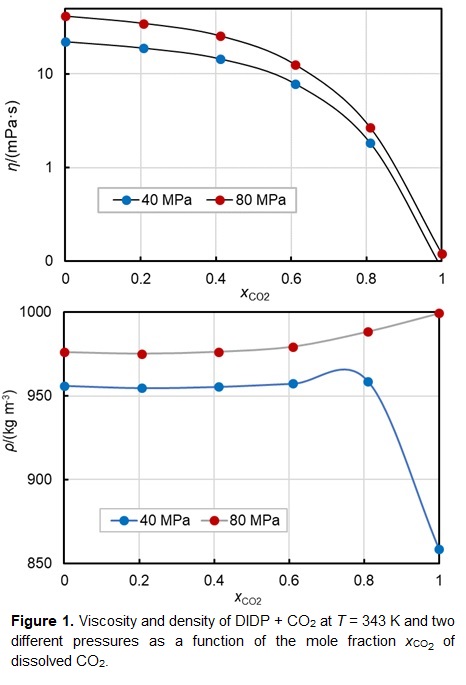2020 Virtual AIChE Annual Meeting
(37d) Influence of Dissolved Carbon Dioxide on the Viscosity of Di-Isodecyl Phthalate
Authors
Introduction
It is well established carbon dioxide dissolves readily in most organic liquids under pressure and leading to a large reduction in viscosity. The extent of the viscosity reduction appears to depend greatly on the initial viscosity of the liquid and previous studies have focused mostly on relatively-low-viscosity liquids [1-4].In this work, we have studied the viscosity of di-isodecyl phthalate (DIDP) under addition of carbon dioxide. The results show a viscosity reduction of up to 98%.
Experimental
Measurements were carried out in a bespoke apparatus comprising a vibrating-wire viscometer and a vibrating-tube densimeter connected in a loop together with a recirculation pump. Fluids (DIDP and carbon dioxide) were injected quantitatively into the loop from high-pressure syringe pumps to create mixtures of known composition at pressures above the bubble curve where they forma single homogenous liquid phase. The circulation pump was used to homogenize the liquid prior to the measurements. The viscosity and density were measured at temperatures of 313, 343 and 373 K with pressures up to 80 MPa.
Results and Discussion
Figure 1a shows the viscosity of the mixture T = 343 K as a function of the mole fraction xCO2 of dissolved carbon dioxide. The figure also shows the viscosity of pure DIDP [5] and pure CO2[6] as end points. As the mole fraction of dissolved CO2 increases from zero to approximately 80 mol%, the viscosity reduces by more than 90%. Figure 1b shows the densities of the mixtures under the same conditions. At a pressure of 80 MPa, dissolution of CO2 is seen to slowly increase the density, while at 40 MPa, there is almost no change up to a mole fraction of 0.8, after which a reduction to the density of pure CO2 is observed. These results demonstrate that the reduction in viscosity is not simply a reflection of density changes.
We also explore the applicability of a recently-developed model for mixture viscosity based on the residual entropy [7] and will present a comparison with this model for the present binary mixture.
References
[1] F. Ciotta, G. Maitland, M. Smietana, J.P.M. Trusler, V. Vesovic, Viscosity and Density of Carbon Dioxide + 2,6,10,15,19,23-Hexamethyltetracosane (Squalane), J. Chem. Eng. Data, 54 (2009) 2436-2443.
[2] M. Mohammed, F. Ciotta, J.P.M. Trusler, Viscosities and Densities of Binary Mixtures of Hexadecane with Dissolved Methane or Carbon Dioxide at Temperatures from (298 to 473) K and at Pressures up to 120 MPa, J. Chem. Eng. Data, 62 (2017) 422-439.
[3] M. Binti Mohd Taib, J.P.M. Trusler, Viscosity and Density of 1,3-Dimethylbenzene + Carbon Dioxide at Temperatures from 298 to 423 K and at Pressures up to 100 MPa, J. Chem. Eng. Data, 65 (2020) 2186-2193.
[4] K. Kian, A.M. Scurto, Viscosity of compressed CO2-saturated n-alkanes: CO2/n-hexane, CO2/n-decane, and CO2/n-tetradecane, J. Supercrit. Fluids, 133 (2018) 411-420.
[5] F. Peleties, J.P.M. Trusler, Viscosity of liquid di-isodecyl phthalate at temperatures between (274 and 373) K and at pressures up to 140 MPa, J. Chem. Eng. Data, 56 (2011) 2236-2241.
[6] V. Vesovic, W.A. Wakeham, G.A. Olchowy, J.V. Sengers, J.T.R. Watson, J. Millat, The Transport-Properties of Carbon-Dioxide, J. Phys. Chem. Ref. Data, 19 (1990) 763-808.
[7] M.B.M. Taib, J.P.M. Trusler, Residual entropy model for predicting the viscosities of dense fluid mixtures, The Journal of Chemical Physics, 152 (2020) 164104.

